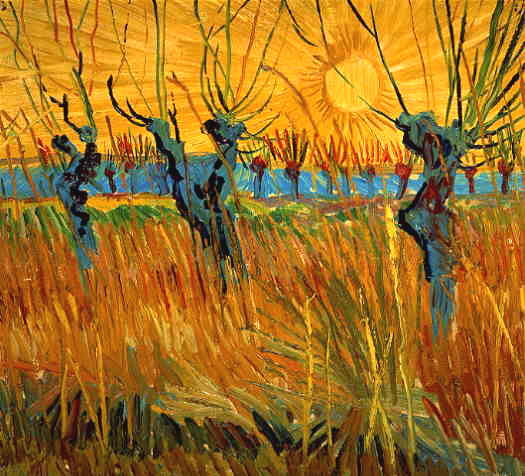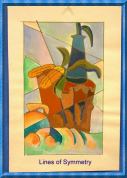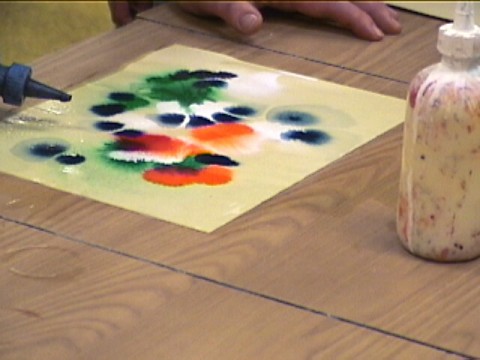|

1.
Color Detail 1: Colored line and texture.
3 Days.
General Assignment Idea: Interpret picture(s)
or invent picture(s) which is rich in detail.
Challenge:
Do as many pictures as time allows in 3 days.
No less than one a day!
Detail can be "descriptive" describing certain
kinds of detail,
Detail can also be patterned, stylized lines
or textures,
Detail is secondary breakup. (inside of the
main forms of the picture.)
Select as many bright
colors as you can.
HINT -
Do not be limited by what you imagine are
the normal ‘"realistic"’
color choices.
Skills: Using a fine pointed brush,
using detail with good control bright colors,
vivid hues of color.
Media and Materials: Use tempera paint
which is bright, colorful and opaque. Small
size brushes.
Ideas and Subject selection -
Make it tell a story
or be about something. Describe
something real that you can see. Or paint
something whose details you are very
familiar with. Use many bright lively colors
as colored line. Emphasize line and textures.
You may suggest textures by using small marks,
dots, lines, small circles, etc.
Limitations -
Do not attempt to blend colors -- to make
colors realistic -- or to fill in solid areas.
Design: Include more than one form
in your visual content (Object with setting)
Do not try to fill a large picture
space with tiny detail (Too much labor
and time would be required.)
The
picture size will probably work best
at 9x12
Time:
One or more can be done easily in one day.
But you work with this method for 3
days.
If
you finish early repeat the technique
again with variation for extra credit, trying
to be more creative, often your best
work comes with more practice and more freedom
to express "creative play."
Inspiration from
Examples -
Artists: See Van Gogh, Matisse, Vlaminch,
Fauvism

2.
Color Assignment 2, Still life: 4 Days
General Assignment Idea: Create a still
life setup. Interpret the still life display
using abstraction methods You will observe
and then reinterpret the forms in this design.
Different Kinds of Abstraction:
Use any of the following methods of abstraction:
Overlapping, transparency, Lines of symmetry,
or faceting. You will be given
samples or have explanation of these methods.
Medium: Blended tempera or poster color.
Skills: Composing objects in space;
and drawing skills - esign skill using interesting
breakup of the picture space- Mixing color
blends or tones; Using a palette. - Applying
color with control.
Hints:
Painting in areas of solid or graded color
tones - Color harmony should be planned,
Borrow a color scheme from another famous
artist, note his or her color choices. and
make a note to use these. Consider a "dominant
color" and "color contrasts."
Design: Picture size: 18x24 with border
or 16x20 (trimmed size)
•
Time: 4 days Artists:
Picasso, Braque, Gris, Feininger
3.
Color Assignment 3. Still life, Realistic:
6 days
General Assignment Idea: Organize a
still life display which has good variety
in shape, color, size and textures.
Skills: Use the same skills as described
above, But you will be achieving true life
outline and tone and color.
Materials or Media: Work with acrylic
paint on canvasette
Size: 18x24 with added border of 1.5
inches Color
4. Color Assignment 4. Life Drawing
(modeled human or other animal )
Modeled and tonal, means showing 3d-ness,
as opposed to a flatness that results from
no tonal shading.
General Assignment Idea: Use light
and shadow illuminate a human forms or some
other kind of life form, draw them as large
as possible inside the picture space.
Design approach: Emphasize the masses
of the body and the light and shadow illuminating
the body. Give the form a 3d environment though
it may be simple.
-
Size: 18x24 with border.
-
Time: 6 days to do one painting.
-
Media: limited palette, paint media,
brushes
-
Artists to Study: Caravaggio, Rembrandt,
Rubens, Picasso (1921), Henry Moore,
Botero

5.
Color Assignment 5. Serendipitous Water Color
Wash Techniques: Use tempera or water color
washes.
(Discovering visual effects in fluid washes)
General Assignment Idea: Discover visual
qualities. What makes the accidental flow
and blend of colors beautiful? They are rich
in purely visual effects; color, line, texture,
shape are of great variety and which
are rich and infinitely variable. Use
transparent washes and wet in wet affects
which express fluidity and spontaneity with
the medium. Do Not overwork any of the color
areas. The accidental of serendipity quality
of wet in wet is such that you can not
always predict it try to allow for these effects
to happen on their own and do not rework
that which happens in a spontaneous fresh
way.
This kind of art begins as play but must eventually
be transformed and interpreted as some kind
of subject or story using the wonderful visual
results.
Medium:
Water Color transparency happens with adding
water to the paint until it is
mostly water. Though tempera or poster color
is considered an opaque and not transparent
medium it gives nice effects when very fluid.
it is not quite as good for washes as water
color tubes or water color cakes. We
will do the art
by accident
approach with a thinned out tempera dropped
and dripped and folded and tipped on a wetted
piece of paper. Once dried the effects can
be studied for possible
Imaginative interpretation
Subject matter: the most challenging
upon your imagination thus far. Follow up
by adding line and some additional color tone
to develop the vision that you discovered
within your accidental universe. Make an effort
to preserve the visual effects that have been
made by accident!!
Selection: Select a subject that you
are inspired to use after doing a little experimenting
with serendipity. (Accidents that produce
amazing results=serendipity).
HINT:
The wet into wet paper blends are very effective
to create the illusion of atmosphere, foliage,
storms, seas, fur, flowers, etc.
Size 16x20 to 18x24 with border margin.
Time: Allow One day for the wet in
wet sketches and, 1to 2 days follow-up to
clarify and complete with detail touch ups.
Production:: Do no less than two of these
in 1 week's time.
6
Color Design 6:
Water color quick figure sketches“
Technique: "Wash" sketches with
pen detail.
General Assignment Idea: Capture the
essential pose and the proportions of the
the human figure with “visual shorthand.”
Work with a light wash from watercolor or
tempera as in 5 above, you are to complete
gesture drawing silhouettes of human figures
in natural action poses:
HINT:
Do not use a heavy application of paint. Do
not "cross out any less than perfect
sketch. Try to improve your skills while you
work with a brush and wash method.
Figure proportions: Not
too many people have a good sense of figure
proportion so it is advisable that you review
figure drawing proportion (1 to 7) with a
guide sheet from your teacher. Some of these
may be from pictures but be sure that the
majority or from real life models. Use
the head length as the guide to proportion.
Design: Create a "montage"
or multi image per page approach. Your art
will have the appearance of practice or "studies"
or practice works but they should still
be done
sensitively and caringly.
Please consider size variation and position
of the images
Page size: 9x12 or 12x16 inch Drawing
paper.
Time: You will work with wash and pen
for 3 days or until you have a minimum of
six pages of studies
Painting
7: Surrealism (Fantasy Images)
General Assignment Idea: Organize objects
which can represent personal symbols, or juxtapositions
of forms to
suggest fantasy or psychological content.
Ask for the fantasy
painting guide sheet.
HINT:
To understand the concept of “irrational,”
Look up Magritte, Dali, Arp,
Kandinsky
or "Surrealism". To underastand the concept
of pure visual texture look up,
Kandinsky. Do some concept sketches
of your idea before you proceed. Search
and
examine internet web pages dealing with 3d
ray-tracing and phantasy environments.
Medium: Acrylic on canvas tablet
Size: 16x 20
Time: No more than 6 class days.
Assignment
8 : Pattern and Texture-producing art techniques:
General Assignment Idea: The painting
knife which can be used either with a degree
of realism or used in a semi-abstract sense.
The effects of paint applied by a blade cause
an
interesting effect of texture when blending
or "scumbling" painting over a previous
paint color layer.
Experiment; this is a new techniqe
so experiment to discover the textures which
come from using a palette knife.(Or a stiff
piece of card board to apply paint.)
Dry brush is another effect: As the
paint runs out on the knife or brush it produces
a soft texture,
the "dry brush" look.
Subject matter: Select subject matter
that is compatible to the method don't try
anything too realistic.
Painting technique. Do not neglect
content and a sense of subject in an environment.
Size: It is probably advisable to stay
in the 12 to 14 inch size range for the page
or canvas sheet.
Time: No more than 4 class days.
Assignment 9 : Realism, painting
a still life in normal colors and light.
General Assignment Idea: construct
an attractive setting of objects in a group.
Select the
objects to produce size and color contrasts
as well as good line movement to affect a
good
composition.
Blend colors on palette to match those of
your set up.
Subject matter: Select subject matter
that is compatible or suggested by the knife
painting
technique. Do not neglect primary
content and a sense of a main subject
in its own environment.
Size: 12 x 16 inch minimum size or
larger. Choose canvas or heavy paper sheet.
Time: No more than 5 class days.
Color Design 10 Pastel. Torn
paper frisket / stencil method. Semi-abstract.
General Assignment Idea:
A stencil allows color to go
inside a shape to leave that area filled with
color or tone.
A frisket allows color to trace
outside the edge of the torn or cut pattern.
Using a direct
approach or cotton balls apply color blends
over the top of torn or cut paper edges onto
a plain sheet of paper.
A “Frisket” uses the edge of a
guide form and a stencil uses the inside or
cut- out areas.
Selection: Select a subject which is
simple but interesting. Think semi abstractly
on stencil
images with very simple, easy shapes.
Friskets make beautiful patterns and
can
be torn out or cut with as much complexity
as you feel comfortable with.
Return to Arts Homepage
|

